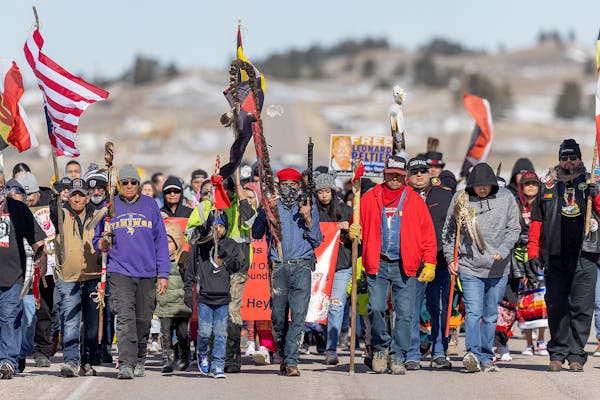WOUNDED KNEE, S.D. — They marched for more than two hours north toward this village on the Pine Ridge Indian Reservation on a cold and gusty Monday morning, through the hills where their Indigenous ancestors took a historic stand against the U.S. government 50 years before.
"This valley has a lot of history," said Lakota leader Wade Broken Nose from the back of a pickup truck.
As they stopped to rest, he told the crowd of dozens how the U.S. cavalry massacred nearly 300 Lakota people at Wounded Knee in 1890 — and then, following decades of oppression, traditional Oglala Lakota grandmothers in February 1973 called in American Indian Movement (AIM) activists from Minneapolis to help fight what they deemed corrupt tribal leadership and decades of oppression from the federal government. It led to a 71-day standoff with federal agents in which two Native occupiers were shot dead, a U.S. marshal was paralyzed and unprecedented public attention turned to treaty violations with American Indians and demands for Indigenous rights.
"Remember this: as you go in [to Wounded Knee], you're going in for your relatives, your ancestors," Broken Nose said Monday. "You're going in for yourself and your family, and the main thing, you're going in for that future."
Marchers shook one another's hands and began the final stretch of their walk, breaking into chants to the beat of drums. With the highest-profile leaders dying in recent years — including Clyde Bellecourt, Dennis Banks and Russell Means — it was their children and grandchildren continuing the fight. Attendees felt a special calling to pay their respects and pass on their legacy to the youngest among them.
Lani Moran-Blake allowed her 7-year-old son to miss school for the occasion, walking next to him as a flag honoring their Omaha Tribe fluttered around his shoulders. She is secretary of the AIM Grand Governing Council who left Minneapolis in 2016 to care for family in Nebraska but still returns frequently.
"This is living, this is what our people went through," said Moran-Blake, who still recalls making the walks with Bellecourt before his death last year.
Like some other Indigenous people gathered in Wounded Knee, she noted that her elders spoke little about the occupation when she was a child, quieted by a culture of fear and trauma. Even the powwows and ceremonies held in honor of the Wounded Knee occupation this past weekend, some noted, would never have been allowed in 1973. That they could practice them so openly was a testament to activism that helped later that decade to end legal prohibitions on Native American people practicing their religion.
Just after 1 p.m. they walked up the hill of Wounded Knee, converging with parades of hundreds of Indigenous marchers coming from the west and the east and the north, over snow and mud.
Gun salutes pierced the quiet of the hills.
Bill Means, one of the dwindling number of living Wounded Knee occupiers, addressed the mass of people before him as a contingent of Minneapolis activists stood nearby. The hundreds of Lakota people buried behind them, he said, is why they resist.
"We didn't just come here to raise hell," said Means of 1973. "We had to make a statement to tell the world that Indians are still alive, this is still our land."
Bellecourt's son, Crow Bellecourt of Minneapolis, told the group that his father was there with them Monday.
Elders in the American Indian Movement, said Crow Bellecourt, made it so that "we can sing and dance, we can pray. We can do these things now because they stood up right here in Wounded Knee, so it's a proud day for me. ... We're all AIM. We're all together."

Fall or spring, it's Rochester Mayo's year in prep tennis

Minneapolis reaches $150k settlement with eyewitness of George Floyd's murder

Israel-Hamas war creates 'really fraught times' at Minn. colleges

Rare and fatal brain disease in two deer hunters heightens concerns about CWD

